pdp-15 XVM (2)
Serial Number ????
Here we go again... The pdp-15 was an 18-bit machine built in the early
1970s as a successor to the pdp-9 and pdp-7, themselves direct descendents,
in the 18-bit line, of the pdp-1, DECs first system. They were typically
used in data acquisition and analysis, engineering, early graphics systems,
and experiment and process control. Towards the end of their life cycle,
they were repackaged as 'XVM' systems, with a much modified and larger
memory subsystem, and a pdp-11 front end. These were DECs last 18-bit systems,
and were substantially replaced by the 16-bit pdp-11.
The historic importance of DEC 18-bit systems cannot be underestimated:
the pdp-1 got DEC into the computer business, and was a highly significant
machine in the development of hacker culture, at MIT in particular - the
first computer game, Spacewar, was written on the pdp-1. The followup pdp-7,
also 18-bit, was the machine on which Unix was developed and first ran.
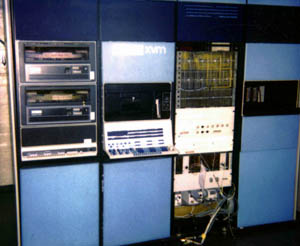
An old polaroid of the system in situ before I removed it...from left to right, 11/10 front end with 2 RK05
disks, the cpu/memory box and console, the fpu with a lot of custom h/w
in the bottom of the cab, and a substantially empty cab on the right.
This particular system, the second 15 I collected, had been used at British
Aerospace near Preston, England, as part of the control system for the
Tornado hydraulic systems test rig. It had been on Digital maintenance
right up to the time when I collected it, in 1997, along with some pdp-8e
systems from the same rig. It came with the RK05 cartridge that is in the
drive, and a set of PIREX paper tapes - PIREX being the operating system
for the 11/05 front-end.
When I got hold of it, it was still in fully operational condition, and
although it hadn't been used for several years, it had been powered up
for maintenance. I didn't hesitate to power it up myself, before dismanting
it, and it worked! I wasn't familiar enough with the configuration to attempt
a boot, but played with the console for a few minutes (Aha! That's how
it's supposed to work... see my earlier experiences with my first pdp-15).
These fun and games were brought to a halt by a flash and a bang from the
back of an RK05... ah, well... power down and spend the next few hours
in a very careful systematic dismantling and loading into the back of a
van.
Unlike pdp-15(1), this system has no 18-bit disk or tape control - software
is loaded from the RK05s which are connected to an RK11 controller in the
pdp-11 front end. It has an FP15 floating-point unit, however. Some more
photographs... as usual you can click on any image to see the full high-resolution
version.
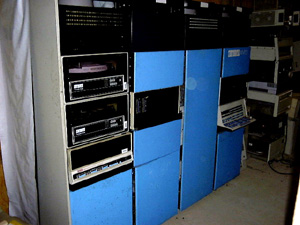
Safely home in the Corestore...

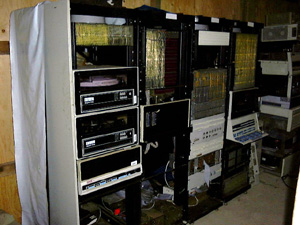

With and without covers...

Closeup of the CPU & console...
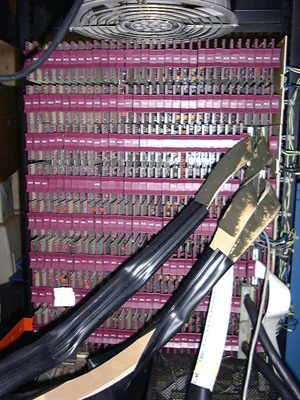
... and the CPU cards.
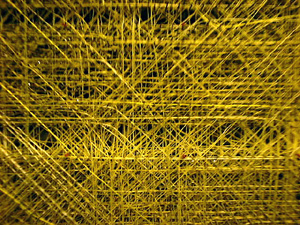
Backplane is a rats nest!

FP15 indicator panel...
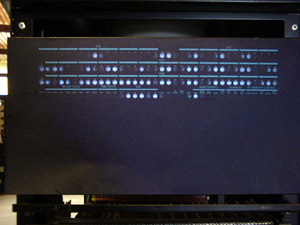
...powered-up with lights on.

Lastly a more recent and much higher-resolution view... RP06 from DECSYSTEM20
in foreground, pdp-8e x2 & DF32 in background. The RK05 cartridge in
drive '0' is labelled 'WD601 MAIN SIM' - presumably a reference to the
hydraulic simulator rig the system was used on.
There are very very few pdp-15 systems still in existence... I know of
four:
1. This one!
2. My other one!
3. There was one in the offsite storage facility of a Scottish museum -
it was part of a collection of medical equipment, hooked-up to a scanner.
4. Rob Garners machine in the USA.
5. Max Burnet has one in Australia.
6. Errrrrr I'm sure there are others, but that's all I know of at present. Any other pdp-15 owners, please get in touch!
http://simh.trailing-edge.com/docs/advmonsys.pdf Bob Supnik has written a fascinating document on restoring pdp-15 software
(pdf format)
http://simh.trailing-edge.com/docs/architecture18b.pdf Bob has also written a document on the evolution of 18-bit systems (pdf
format)
http://www.unusual.on.ca/unusual/pdp15.jpg Kevin Stumpf had one; it's now in the capable hands of Robert Garner.
http://www.acms.org.au/burnet-max.htm Max Burnet has one in Australia.










